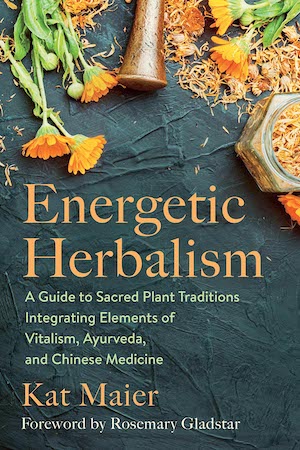
A Guide to Sacred Plant Traditions Integrating Elements of Vitalism, Ayurveda, and Chinese Medicine”
By Kat Maier
Chelsea Green Publishing, 2021
392 pages, paperback, $24.95
Kat Maier has been a practicing herbalist for over 30 years and it is clear from her writing in “Energetic Herbalism: A Guide to Sacred Plant Traditions Integrating Elements of Vitalism, Ayurveda, and Chinese Medicine” that she is well versed in her craft. This new book explores the underlying energetic connection with nature that many different herbal traditions from across the globe hold while distilling these connections into a guide that can be easily understood.
“Energetic Herbalism” has something for everyone and is highly accessible due to Maier’s recommendation for people to get outside and personally experience connecting with plants. She gives guidance for approaching nature directly, dropping into one’s heart space and acknowledging the sensations that come from that. She encourages people to return to plants they have connected with in different seasons, building deep relationships and learning about the medicine of place. She nicely connects this with the work of United Plant Savers and the conservation of wild endangered medicinal plants through growing one’s personal relationship with them.
In a separate chapter she delves into the medicine of the seasons. For each season Maier gives an overview of prominent elements, related organs, tastes and tissues states. Maybe most helpful to the reader, though, is advice on what to eat or herbs to take to best support the body during the different parts of the year. The whole book is interspersed with recipes and preparations.
One topic in this book not often found in other herbals is formulation. Specifically, Maier addresses the Triune System of formulation developed by William LeSassier. She refers to him as the “teacher’s teacher.” LeSassier died in 2003 and, while I have heard him referred to many times from herbal teachers, this is one of the first times I have seen his name and the system of formulation he used referenced in print. For herbalists beginning to work with clients, learning a system of formulation is an important aspect of the journey and is an element of this book that widens the scope of its audience. Maier also references other herbalists and herbal authors in her writing including 7Song, David Winston, James Green and many more.
A materia medica of 25 plants is included, with brief but key information on how to grow and harvest the plants in addition to uses, indications and preparations. This additional growing information is so helpful for readers who want to get to know these plants through hands-on experience.
This book can be returned to time and time again for a deeper understanding of the vast world of herbal traditions as well as for quick, nurturing tidbits that can be incorporated into daily life and seasonal routines.
Denise DeSpirito, Of the Spirit Herbals, Owls Head, Maine
